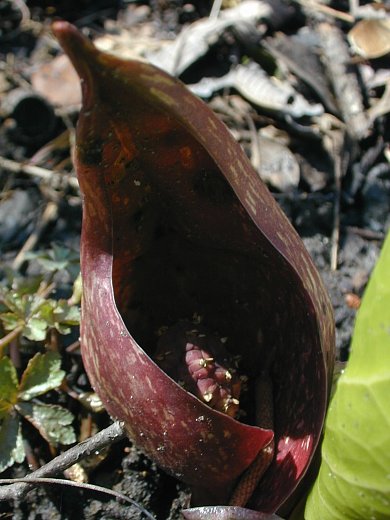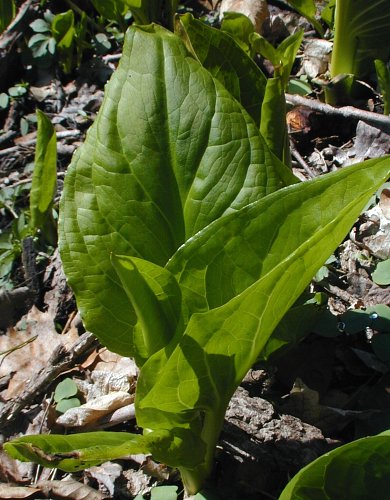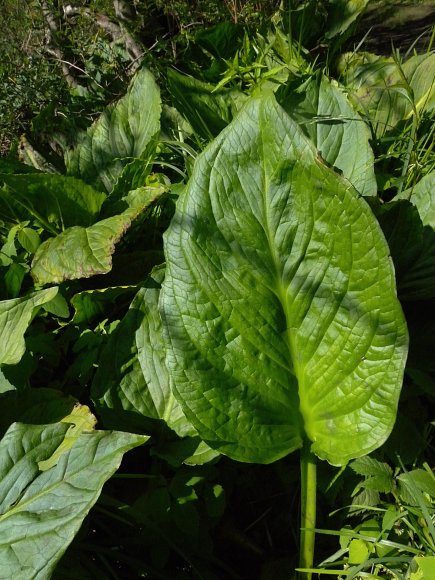Description: This perennial plant produces a rosette of basal leaves during the spring; these leaves reach their maximum size by early summer, and they wither away by the end of summer. The blades of these leaves are up to 2' long and 1' across; they are medium to dark green, oval or oval-ovate, smooth along the margins, and hairless. The petioles of the leaves are initially quite short, but they later become up to 1' long; these petioles are light green, stout, hairless, and concave along their inner/upper surfaces. The leaf blades have prominent veins, especially on their lower surfaces. The inflorescence consists of a spadix that is surrounded by a curved spathe; they are located near the ground. The curved spathe is about 4-6" long and half as much across; it tapers to a point at its apex. The convex outer surface of the spathe has stripes, streaks, or spots of purple and green; this surface is smooth and hairless. On one side, the spathe remains open to reveal a globoid-ovoid spadix about 2" long. This spadix is covered in all directions with small perfect flowers. Depending on the local ecotype, the spadix can be pale yellow to dark purple.

Each flower is about ¼"
across, consisting of 4 pale sepals, no petals, and the reproductive
organs. The inflorescence develops during early spring, before the
leaves unfurl, at which time the small flowers bloom. They emit a
carrion-like odor that flies can detect. The bruised foliage of this
plant can produce a similar odor. The spathe soon withers away, while
the spadix becomes enlarged into a compound fruit with a blocky
surface. This globoid-ovoid compound fruit becomes about 4" tall and 3"
across; it is initially green and dark purple, but later becomes dark
brown or black as it disintegrates. The compound fruit is mature by
late summer or early fall; it becomes malodorous with age. Each simple
fruit contains a single large seed about 1/3" (8 mm.) across, or a
little
larger. Unless the fruit is eaten or carried off by some animal, the
seeds fall to the ground near the mother plant, where they often
germinate. The root system consists of an elongated rootstock up to 1'
long and 2-3" across; it is surrounded by a mass of thick fibrous
roots. Skunk Cabbage reproduces by reseeding itself; it does not
reproduce clonally through rhizomes. Colonies plants often develop
at favorable sites.
Cultivation:
The preference is partial sun to light shade and consistently wet mucky
soil. Shallow standing water is tolerated if it is temporary. This
plant dislikes excessive heat from strong sunlight. The seeds are
hydrophilic and shouldn't be allowed to dry out before they are planted.

Range &
Habitat:
The native Skunk Cabbage occurs in the northern half of Illinois,
particularly in NE and north-central areas of the state, where it is
occasional (see Distribution
Map). Elsewhere, this species is uncommon or absent. Skunk
Cabbage has a boreal distribution in North America and it also occurs
in NE Asia. It is possible that this species crossed the Bering Land
Bridge during one of the ice ages to reach North America. Habitats
include wet deciduous woodlands, swamps, wet thickets where some
underground seepage occurs, edges of fens, seeps along wooded
hillsides, and springs. This conservative species is usually found in
shady wetlands. In more northern areas, it is also found in bogs.
Faunal Associations:
The flowers are pollinated by flesh flies (Sarcophagidae),
carrion flies (Calliphoridae), and various gnats.
These insects are attracted by the carrion-like appearance of the
inflorescence and its unpleasant odor. The attractiveness of the
flowers is enhanced by the increased temperature that is maintained
within the spathe during the early spring. The caterpillars of Phragmatobia
fuliginosa (Ruby Tiger Moth) feed on the foliage of this
plant; this moth is polyphagous. Young larvae of Bellura obliqua
(Cattail Borer Moth) typically mine the leaves of the plants that they
infest, while older larvae bore into the crowns. Slugs and
snails occasionally feed on the foliage of Skunk Cabbage.
Spiders often lurk within the spathes to feed on insects that visit the
flowers.

The toxic foliage
is inedible to most vertebrate herbivores
because it contains crystals of calcium oxalate. However, after they
emerge from hibernation during the spring, hungry Black Bears and
Snapping Turtles occasionally eat the foliage, when little else is
available, after they come out of hibernation.
Photographic Location:
A wet thicket at the edge of a woodland where there was some
underground seepage of water from a neighboring bluff. This thicket was
located near the Collinson Marsh in Vermilion County, Illinois. The
photograph of mature leaves was taken at a sandy slough in a wooded
area of the Oak Openings Nature Preserve in NW Ohio.
Comments:
This is a very weird and striking plant. It is the first native
wildflower to bloom during the spring.